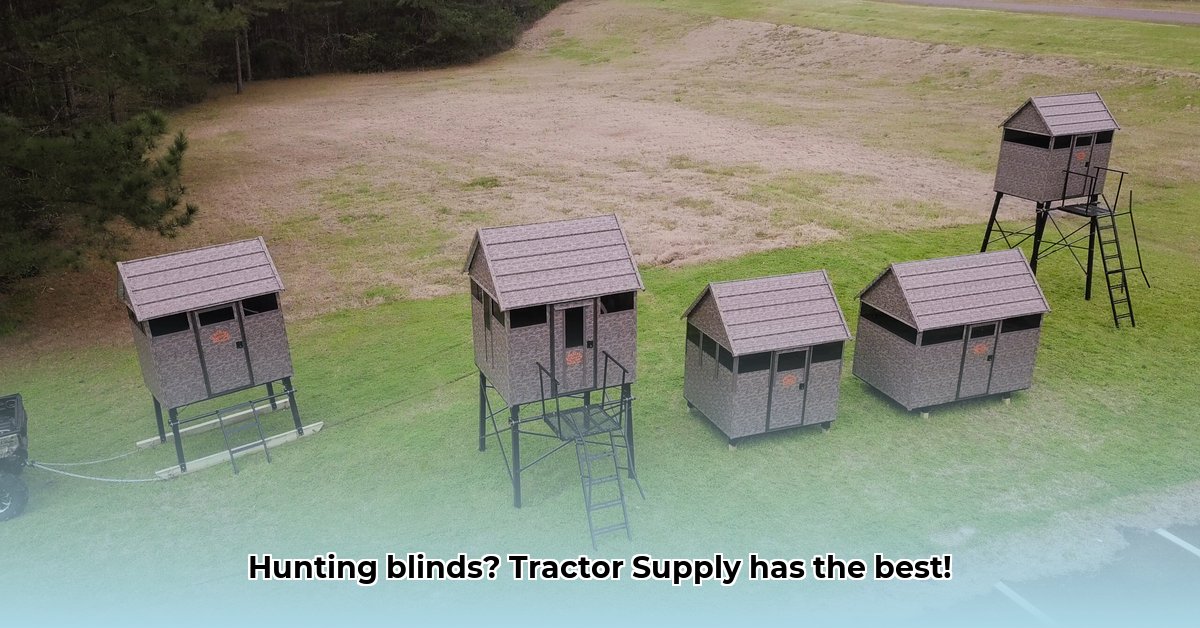
Choosing the right hunting blind can significantly impact your hunting success. Tractor Supply offers a wide selection, making it crucial to understand the different types and features to find the perfect fit for your needs and budget. For more outdoor gear options, check out Tractor Supply's other products here. This buyer's guide will help you navigate the options and make an informed decision for a successful hunting season.
Understanding Hunting Blind Types
Tractor Supply stocks various hunting blind types, each designed for specific hunting styles and environments. Understanding these differences is the first step in making the right choice.
Ground Blinds: These portable shelters are ideal for hunters who frequently change locations. They're typically easier to set up and transport than other types, offering a blend of portability and concealment. However, they generally offer less protection from the elements.
Box Blinds: These more permanent structures often provide superior weather protection and concealment. Many are designed for fixed locations and offer more space and comfort, ideal for hunters who primarily hunt in one area for extended periods.
Tree Stands: Offering an elevated vantage point, tree stands provide a significant advantage in terms of visibility and shot placement. However, they demand greater care and safety precautions due to their height. Always prioritize safety and proper harness usage when selecting and using a tree stand.
Key Features to Consider When Choosing a Hunting Blind
Several key features can greatly affect the success and comfort your hunting session. Carefully evaluating these criteria before purchasing will increase the likelihood of satisfaction with your new blind.
Camouflage: Effective camouflage is paramount. Consider the surrounding environment and select a pattern that blends well with the terrain and vegetation. Poor camouflage could compromise your entire hunt.
Weather Resistance: Durable materials such as heavy-duty polyester or weather-resistant fabrics are essential, especially if you hunt in challenging weather conditions. Consider waterproofing features and ventilation for optimal comfort in different climates.
Comfort and Space: The amount of space within should be suitable for the number of hunters using the blind. Additional features, such as padded seats or shooting windows, can dramatically improve the overall hunting experience.
Portability and Weight: This factor is key if you frequently change hunting locations. Lighter, more compact models will ease transportation, while heavier options usually provide greater structural strength and weather resilience. Consider your hunting style and how far you will need to carry your blind to determine the correct balance of portability and durability.
Comparing Popular Tractor Supply Hunting Blind Models
This table provides a comparison of several popular hunting blinds available at Tractor Supply. Prices are approximate and subject to change, so always check the current price on the Tractor Supply website.
| Model Name | Price Range | Capacity | Materials | Camouflage | Pros | Cons |
|---|---|---|---|---|---|---|
| Ameristep Caretaker | $100 - $150 | 1-2 | Polyester/Metal | Realtree | Lightweight, easy setup, affordable | Limited weather resistance |
| Guide Gear… | $150 - $250 | 1-3 | Polyester/Metal | Mossy Oak | Durable, spacious, good price-performance | Can be bulky to transport |
| [Model 3] | [Price Range] | [Capacity] | [Materials] | [Camouflage] | [Pros] | [Cons] |
| [Model 4] | [Price Range] | [Capacity] | [Materials] | [Camouflage] | [Pros] | [Cons] |
Setting Up Your New Hunting Blind: A Step-by-Step Guide
Proper setup is crucial for maximizing your blind's effectiveness and ensuring your safety.
- Read the Instructions: Carefully review the manufacturer’s instructions before assembling your blind. This will prevent errors and potentially dangerous mishaps.
- Choose Your Location Wisely: Consider factors such as wind direction, visibility, and proximity to game trails.
- Assemble the Blind: Follow the instructions precisely, taking your time to ensure proper assembly.
- Camouflage Strategically: Use natural materials like leaves and branches to blend the blind seamlessly into the environment.
- Practice Before the Hunt: Set up the blind in advance to ensure familiarity and address any potential issues before your actual hunting trip.
Safety First: Essential Hunting Blind Safety Tips
Safety is paramount. Always:
- Inspect your blind thoroughly for damage before each use.
- Never enter a tree stand without a safety harness.
- Be aware of your surroundings and potential hazards.
- Hunt with a partner whenever possible.
- Follow all firearm safety regulations.
Key Takeaways:
- Research thoroughly to find the best hunting blind for your hunting technique and environment.
- Consider factors like camouflage, weather resistance, and comfort.
- Prioritize safety throughout the entire hunting process. Always double-check your equipment and follow safety guidelines.